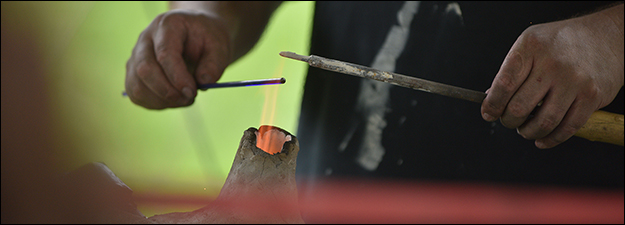Rhetoric and Voice across the Fifteenth Century (A Roundtable)
Sponsoring Organization(s)
Special Session
Organizer Name
Taylor Cowdery, Spencer Strub
Organizer Affiliation
Harvard Univ., Univ. of California-Berkeley
Presider Name
Nicholas Watson
Presider Affiliation
Harvard Univ.
Paper Title 1
The Voice of Skelton's Parrot
Presenter 1 Name
Taylor Cowdery
Paper Title 2
Compilation and the Rhetoric of Immediacy
Presenter 2 Name
Katherine Zieman
Presenter 2 Affiliation
Univ. of Oxford
Paper Title 3
Catachresis and Historicity
Presenter 3 Name
Julie Orlemanski
Presenter 3 Affiliation
Univ. of Chicago
Paper Title 4
Rape and the Rhetoric of Resistance
Presenter 4 Name
Carissa M. Harris
Presenter 4 Affiliation
Temple Univ.
Paper Title 5
Eleanor Hull's Voices
Presenter 5 Name
David A. Lawton
Presenter 5 Affiliation
Washington Univ. in St. Louis
Paper Title 6
Sinful Voices
Presenter 6 Name
Spencer Strub
Start Date
12-5-2016 1:30 PM
Session Location
Bernhard 158
Description
In a recent essay, David Lawton has advanced voice as a useful category for the analysis of English literature across the long fifteenth century. “It is in the voice,” he writes, “that we hear complicity, or resistance, or anxiety” in writing composed under new regimes of censorship and scrutiny. Indeed, fifteenth-century voices would seem to register the impress of an era of language change, Lancastrian unease, Humanist polemic, orthodox reform, and articulate lay devotion. Rather than reducing a dialogic Ricardian shout to a monologic Lancastrian whimper, these constraints of fifteenth-century culture are precisely what produce, in Lawton's account, the rhetorical nuances of voice to be found in writing composed after the tenure of Henry IV and Archbishop Arundel.
The proposed panel seeks to build upon Lawton’s theory of voice by considering it not as an essential faculty of speech but as the product of rhetorical craft—as what Lawton provocatively terms “a screen.” Thanks to the pioneering work of Rita Copeland, we know that fifteenth-century writers and readers of English poetry understood both the composition and effects of poetry through the disciplinary framework ofrhetoric. These insights occasion a host of new questions: during a period of turbulent change in the arts of language and literacy, what roles do histories of rhetorical praxis and rhetorical theoria play in the construction of fifteenth-century texts and their voices? Do writers as varied as Margery Kempe, Reginald Pecock, Thomas Hoccleve, or John Skelton trace their subtleties of voice to a common rhetorical culture, or even to common theories of rhetoric? How does that rhetorical culture inflect the politics and poetics of writers attached to courts, bureaucracies, universities, and the church? And to what extent does the body—the flesh of the tongue, the gendered pitches of the larynx—function with or against rhetorical performances of voice? --Spencer Strub and Taylor Cowdery, organizers
Rhetoric and Voice across the Fifteenth Century (A Roundtable)
Bernhard 158
In a recent essay, David Lawton has advanced voice as a useful category for the analysis of English literature across the long fifteenth century. “It is in the voice,” he writes, “that we hear complicity, or resistance, or anxiety” in writing composed under new regimes of censorship and scrutiny. Indeed, fifteenth-century voices would seem to register the impress of an era of language change, Lancastrian unease, Humanist polemic, orthodox reform, and articulate lay devotion. Rather than reducing a dialogic Ricardian shout to a monologic Lancastrian whimper, these constraints of fifteenth-century culture are precisely what produce, in Lawton's account, the rhetorical nuances of voice to be found in writing composed after the tenure of Henry IV and Archbishop Arundel.
The proposed panel seeks to build upon Lawton’s theory of voice by considering it not as an essential faculty of speech but as the product of rhetorical craft—as what Lawton provocatively terms “a screen.” Thanks to the pioneering work of Rita Copeland, we know that fifteenth-century writers and readers of English poetry understood both the composition and effects of poetry through the disciplinary framework ofrhetoric. These insights occasion a host of new questions: during a period of turbulent change in the arts of language and literacy, what roles do histories of rhetorical praxis and rhetorical theoria play in the construction of fifteenth-century texts and their voices? Do writers as varied as Margery Kempe, Reginald Pecock, Thomas Hoccleve, or John Skelton trace their subtleties of voice to a common rhetorical culture, or even to common theories of rhetoric? How does that rhetorical culture inflect the politics and poetics of writers attached to courts, bureaucracies, universities, and the church? And to what extent does the body—the flesh of the tongue, the gendered pitches of the larynx—function with or against rhetorical performances of voice? --Spencer Strub and Taylor Cowdery, organizers

